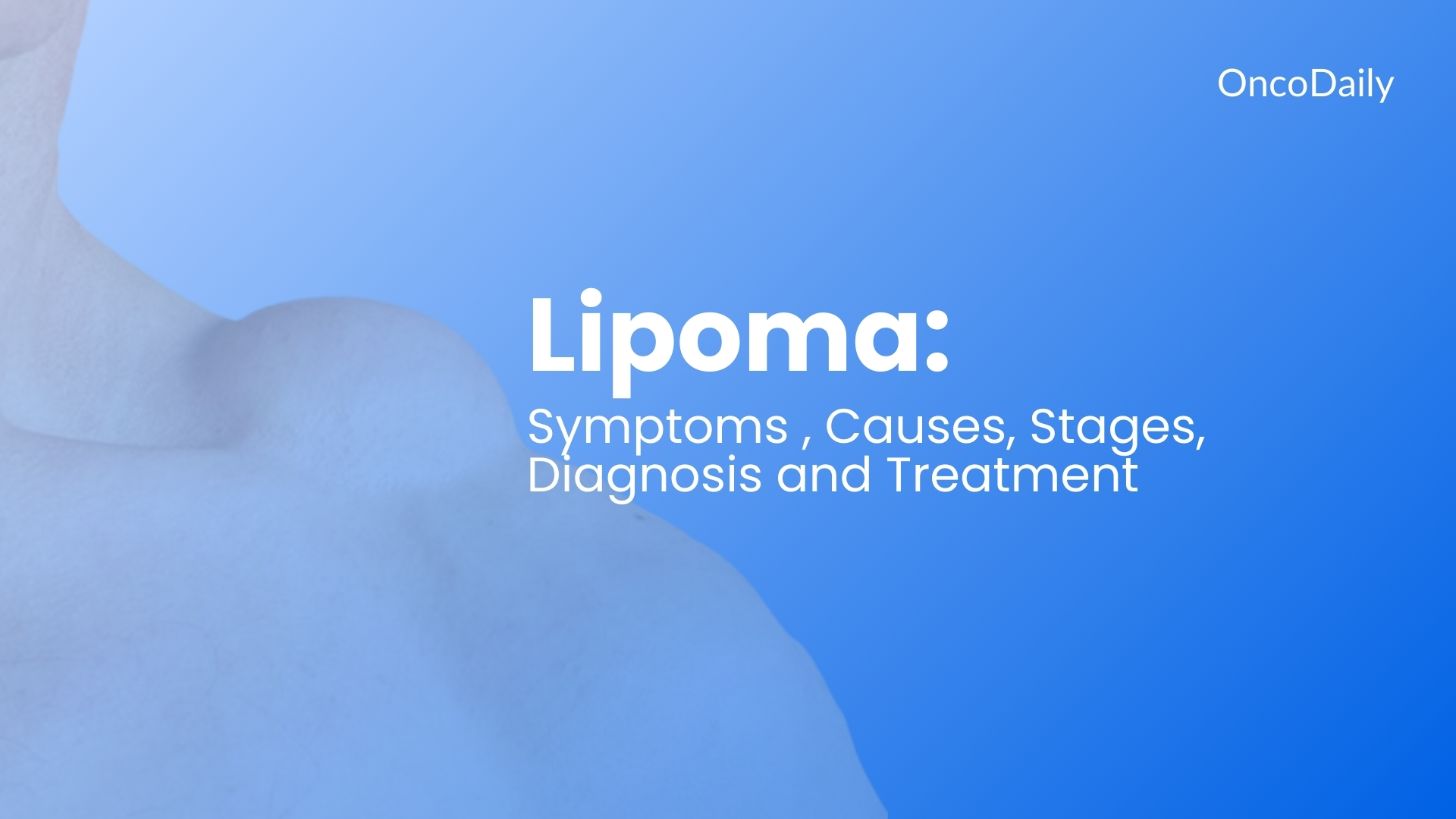What Are the Symptoms of Lipoma?
Lipomas are benign tumors composed of adipose (fat) tissue, commonly presenting as soft, movable lumps beneath the skin. They are typically painless and exhibit slow growth. These characteristics often lead individuals to overlook them until they become more prominent or cause discomfort.
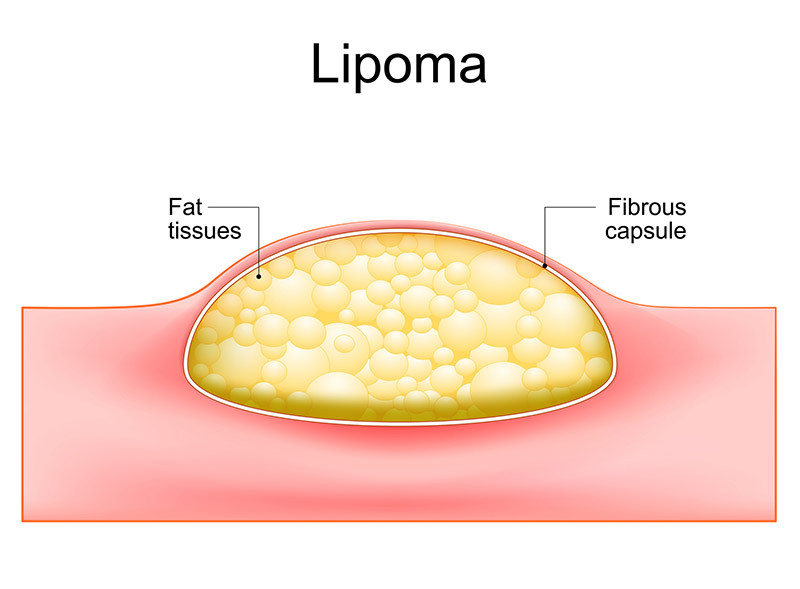
According to a 2024 study by Dr. Emily Thompson, lipomas affect approximately 1% of the population, with a higher incidence observed in adults aged 40 to 60. The study also noted a slight male predominance, with men being 1.5 times more likely to develop lipomas than women.
This article will provide comprehensive information about lipomas, including their types, common signs and symptoms, methods of diagnosis, and available treatment options.
What Are the Early Signs of Lipoma?
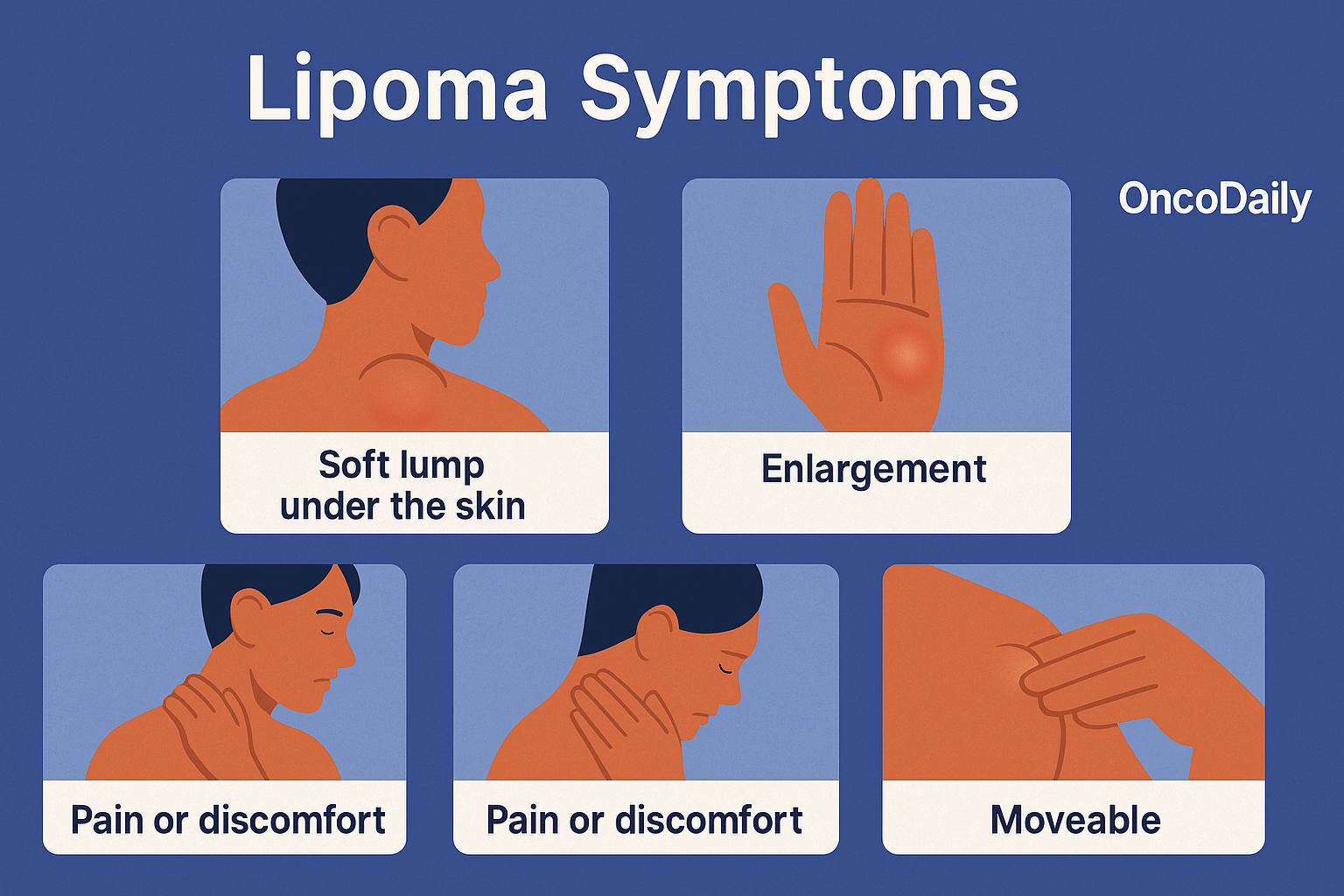
What are the Causes and Risk Factors for Lipoma?
While the exact cause of lipomas remains uncertain, several risk factors have been identified that may contribute to their development.
One major factor is genetics. Familial Multiple Lipomatosis (FML) is a hereditary condition characterized by multiple lipomas, often appearing in early adulthood. It follows an autosomal dominant inheritance pattern, meaning there is a 50% chance of passing it to offspring if one parent is affected. Gene mutations regulating fat cell production are believed to play a role. Additionally, certain genetic syndromes like Dercum’s disease and Madelung’s disease increase the likelihood of developing lipomas, suggesting a genetic predisposition.
Another possible factor is trauma, though this remains controversial. Some researchers propose that injuries could trigger lipoma formation, a concept known as post-traumatic lipoma, but more studies are needed to confirm this link.Hormonal imbalances may also contribute. Since lipomas are more common in women, researchers suspect estrogen and progesterone fluctuations might influence their development. However, there is limited evidence to confirm a direct connection between hormones and lipoma formation.
Certain lifestyle factors have also been associated with an increased risk. Obesity may contribute due to excess fat tissue, while hyperlipidemia—elevated blood lipid levels—suggests a potential link between lipid metabolism and lipoma growth. Additionally, individuals with diabetes mellitus appear to have a higher prevalence of lipomas, hinting at a possible connection with glucose metabolism.
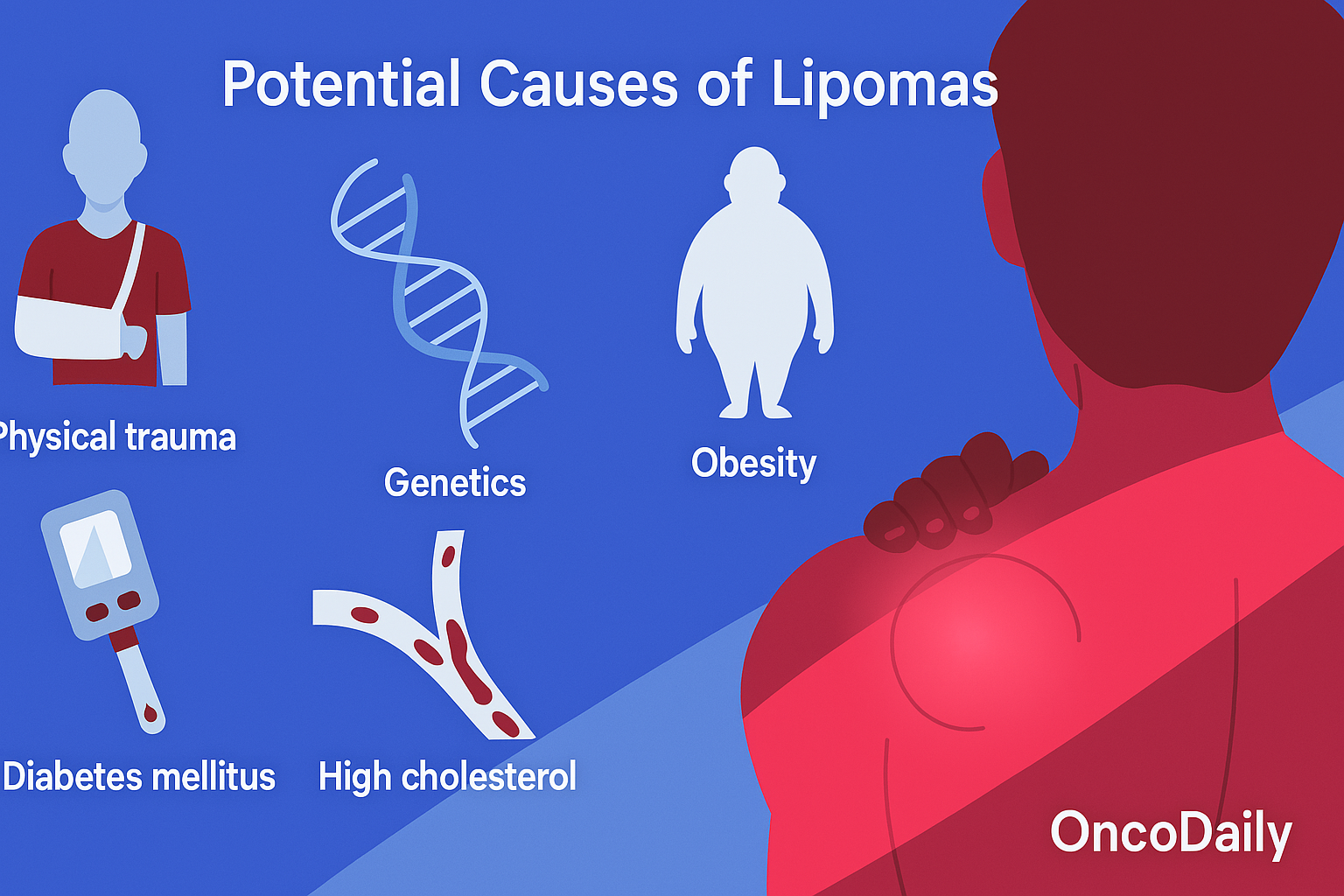
What Are the Types of Lipoma?
Lipomas are classified into different types based on their composition and histological features. The main types include conventional lipoma, angiolipoma, fibrolipoma, and hibernoma. Each variant has distinct characteristics, such as vascular involvement in angiolipomas or the presence of brown fat in hibernomas. Understanding these subtypes is crucial for accurate diagnosis and appropriate management.
Conventional Lipoma
The conventional lipoma is the most common type of lipoma, composed of white fat cells. These benign growthsdevelop just beneath the skin and are typically soft to the touch. They often have a doughy consistency and can be easily moved with slight pressure, which helps differentiate them from other types of growths.
Conventional lipomas vary in size, usually ranging from 1 to 3 centimeters in diameter, though in some cases, they can grow larger, sometimes exceeding 10 centimeters. Their location is typically on the arms, neck, back, shoulders, and thighs, as these areas are rich in subcutaneous fat, making them prime locations for lipoma development.
In terms of symptoms, most lipomas are painless and slow-growing, causing minimal discomfort. However, if they press on nerves or are located near joints, they may cause mild pain or restrict movement. While these lipomas pose no significant health risk, they can be easily removed if they cause discomfort, grow excessively, or affect a patient’s confidence due to their appearance.
Angiolipoma
Angiolipomas are a subtype of lipomas that contain both mature adipose tissue and a prominent vascular component, making them unique from conventional lipomas. Unlike conventional lipomas, which are typically painless, angiolipomas often cause tenderness or pain, especially upon palpation.
These tumors are most commonly found in the forearms, trunk, and upper arms, though they can also occur in other subcutaneous tissues. Pain in angiolipomas is attributed to the proliferation of small capillaries within the tumor, sometimes leading to local pressure effects or microthrombosis within the vascular channels. In contrast, conventional lipomas lack significant vascularity and remain asymptomatic unless they compress surrounding structures.
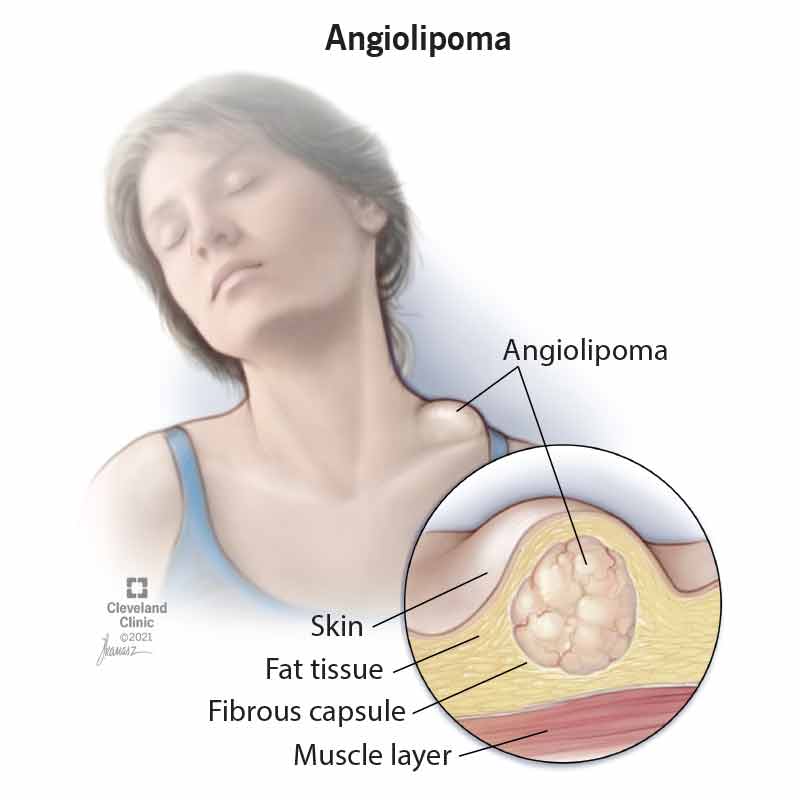
Fibrolipoma
Fibrolipoma is a subtype of lipoma composed of mature adipose tissue interspersed with dense fibrous connective tissue. The increased fibrous content gives these tumors a firmer consistency compared to conventional lipomas, which are typically soft and compressible.
These tumors are most commonly found in the subcutaneous tissues of the back, shoulders, and extremities, though they can also occur in deeper locations, including the oral cavity and gastrointestinal tract. Due to the fibrous component, fibrolipomas may be less mobile and firmer to palpation, sometimes leading to misidentification as a fibroma or other connective tissue tumor.
For instance, a 2024 case study published in the Journal of Soft Tissue Pathology reported a patient with a firm, slow-growing fibrolipoma in the shoulder region, initially mistaken for a desmoid tumor. Histological examination confirmed the presence of mature adipocytes interspersed with thick fibrous bands, distinguishing it from other soft tissue masses.
Hibernoma
Hibernoma is a rare, benign lipomatous tumor composed of brown adipose tissue, a type of fat involved in heat production and energy metabolism. Unlike conventional lipomas, which contain white fat, hibernomas resemble the brown fat found in newborns and hibernating animals, which plays a key role in thermogenesis.
Hibernomas are most commonly found in areas where brown fat persists into adulthood, including the neck, upper back, shoulders, axilla, and thighs. Although they are benign and slow-growing, they tend to be more vascularized than typical lipomas, which can sometimes lead to increased warmth over the tumor site and may require imaging to distinguish them from other soft tissue tumors.
A 2024 study published in Modern Pathology analyzed 56 cases of hibernoma, reporting that the most common locations were the thigh (35%) and interscapular region (22%). None of the cases showed malignant transformation, reinforcing that hibernomas do not pose a significant health risk. However, due to their hypervascularity, they may be mistaken for liposarcomas on imaging, making biopsy and histological confirmation essential for accurate diagnosis.
Myelolipoma
Myelolipomas are rare, benign tumors composed of mature adipose tissue and hematopoietic (blood cell-producing) elements, resembling bone marrow. They are most commonly found in the adrenal glands, though extra-adrenal cases have been reported in locations such as the retroperitoneum, mediastinum, and pelvis.
These tumors are usually asymptomatic and discovered incidentally during imaging studies for unrelated conditions. However, larger lesions (>5 cm) may cause abdominal pain, flank discomfort, or hemorrhage, particularly if they undergo spontaneous rupture. A 2024 review in Endocrine Pathology examined 92 cases of adrenal myelolipomas, noting that 70% were detected incidentally, with only 15% requiring surgical removal due to size-related symptoms. No malignant transformation was observed, reinforcing their benign nature.

How Is Lipoma Diagnosed?
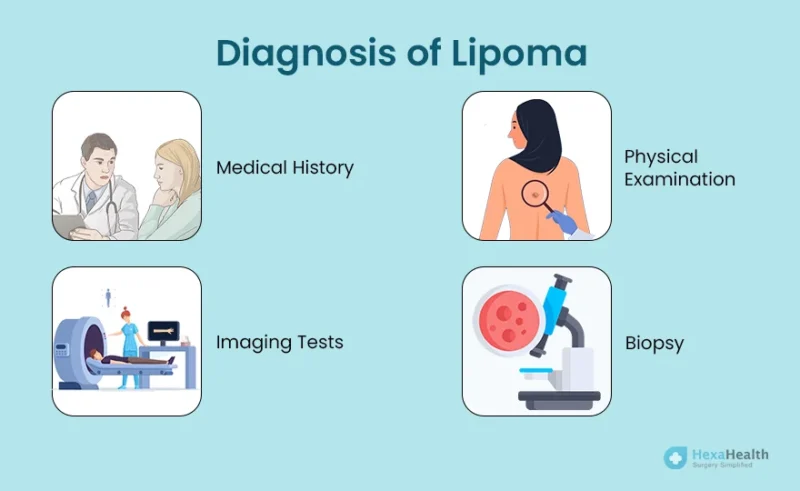
Diagnosing lipomatous tumors involves a combination of clinical evaluation, imaging studies, and histological analysis to accurately distinguish benign lipomas from malignant counterparts like liposarcomas. Clinicians assess the tumor’s size, consistency, mobility, and tenderness. While many lipomas are soft, mobile, and painless, features such as firmness, rapid growth, or pain may raise suspicion for malignancy, necessitating further investigation.
Ultrasound is often the initial imaging modality, helping to determine the lesion’s composition and vascularity. Lipomas typically appear as homogeneous, hypoechoic masses, whereas atypical features may prompt additional imaging. MRI provides detailed characterization of soft tissue masses. A study by Gaskin and Helms reported MRI’s sensitivity and specificity for detecting well-differentiated liposarcomas as 100% and 83%, respectively. However, MRI cannot always reliably distinguish between lipomas and liposarcomas (ajronline.org).
When imaging results are inconclusive or suggest malignancy, a biopsy is warranted. Core needle biopsy (CNB) provides high diagnostic accuracy for adipocytic tumors, particularly for benign lipomatous tumors and higher-grade liposarcomas. A study by Taghipour et al. found that CNB offers strong diagnostic reliability for identifying malignant fat-containing tumors
What Are the Treatment Options for Lipoma?
Surgical Removal
Surgical removal, or excision, is the preferred treatment for lipomas, particularly when they become large, painful, or impact function or appearance. The procedure involves making an incision over the lipoma and carefully removing both the mass and its capsule to minimize recurrence. Typically performed under local anesthesia in an outpatient setting, excision is considered a straightforward and effective intervention.
A study analyzing 319 patients, including 256 with lipomas and 63 with atypical lipomatous tumors, found that surgical excision of lipomas had a local recurrence rate of only 0.8%. In contrast, atypical lipomatous tumors exhibited a significantly higher recurrence rate of 22.6%. The study also noted that complications such as infection, hematoma, and scarring were rare, further supporting the safety and efficacy of excision .
These findings highlight that surgical excision is a reliable and effective treatment for lipomas, offering low recurrence rates and minimal risk. However, outcomes can vary depending on tumor size, location, and the completeness of removal, emphasizing the importance of thorough excision to prevent regrowth.
Liposuction for Lipoma
Liposuction is a minimally invasive treatment option for lipomas, particularly suitable for cases where the lipoma is small or located in areas where cosmetic appearance is a concern. The procedure involves using a cannula to suction out the fatty tissue, resulting in smaller incisions and reduced scarring compared to traditional surgical excision.According to a 2015 study by Silverman et al. published in Case Reports in Dermatology, combining liposuction with limited excision is a safe and effective method for lipoma removal, yielding satisfactory cosmetic results and a low recurrence rate.
In terms of recovery time, liposuction generally offers a quicker return to daily activities. Most patients can resume normal routines within a few days, whereas traditional surgical excision may require a longer rest period, potentially taking weeks before normal activities can be resumed.However, it’s important to note that while liposuction minimizes scarring and shortens recovery time, it may not remove the lipoma’s capsule entirely, which could lead to a higher chance of recurrence compared to surgical excision. Therefore, the choice between liposuction and surgical excision should be made after a thorough discussion between the patient and the healthcare provider, considering factors such as lipoma size, location, and the patient’s preferences.
After Treatment: What to Expect
After undergoing lipoma removal, understanding the recovery process, potential side effects, and appropriate follow-up care is essential for optimal healing.Recovery time depends on the method of removal. For surgical excision, recovery typically takes 1 to 2 weeks, depending on the size and location of the lipoma. Patients are usually advised to avoid strenuous activities during this period to promote healing. In contrast, liposuction, a minimally invasive procedure, allows for a quicker recovery, with most individuals resuming normal activities within a few days. However, swelling and bruising may persist for a short time.
Potential side effects vary, though most are mild. Common effects include swelling, bruising, and mild discomfort at the incision site, which generally subside within a week. Less commonly, infection, bleeding, or scarring can occur, but these risks are minimized with proper post-operative care. Using minimal excision techniques can further reduce the chance of scarring.
Follow-up care is crucial for a smooth recovery. Patients should keep the incision site clean and dry, following their surgeon’s instructions regarding bandage changes and bathing. Activity restrictions should be observed, avoiding heavy lifting and strenuous exercise until cleared by a healthcare provider. Monitoring for signs of infection, such as increased redness, swelling, warmth, or discharge, is important. If these symptoms occur, patients should contact their doctor immediately.
How to Live with Lipoma?
Can Lipomas Be Prevented?
While the exact cause of lipomas remains unclear, certain lifestyle modifications may help reduce the risk of developing these benign fatty tumors.
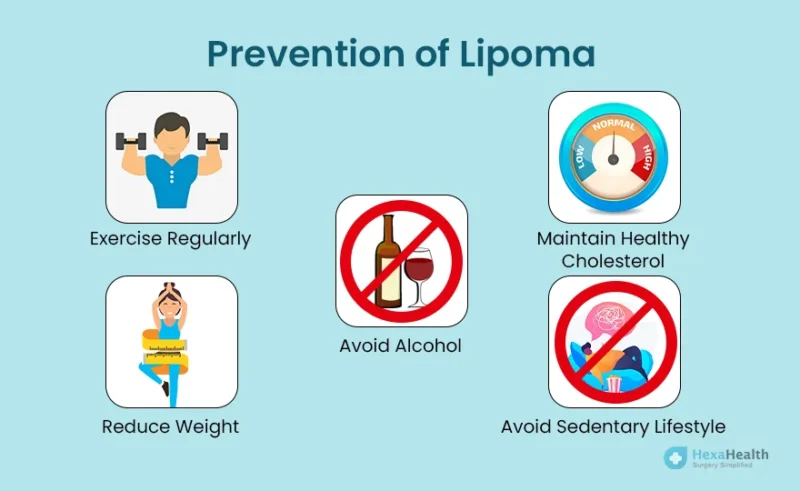
Maintaining a Healthy Weight: Excess body fat has been associated with the formation of lipomas. Adopting a balanced diet rich in fruits, vegetables, lean proteins, and whole grains, combined with regular physical activity, can help manage weight and potentially lower the risk of lipoma development.
Regular Medical Check-Ups: Routine examinations enable healthcare providers to monitor any new or existing growths. Early detection through regular check-ups allows for timely intervention if a lipoma changes in size, becomes painful, or exhibits other concerning features. (ЭпайнАссист)
Effectiveness of Preventive Measures: Specific statistics on the effectiveness of lifestyle changes in preventing lipomas are limited due to the benign nature of these tumors and the lack of extensive research. However, general health benefits associated with weight management and regular medical check-ups are well-documented.
You Can Watch More on OncoDaily Youtube TV
Written by Toma Oganezova, MD
FAQ
What is a lipoma, and how is it different from other lumps?
A lipoma is a benign tumor made of fatty tissue that typically grows just beneath the skin. Unlike malignant tumors, lipomas are soft, movable, and painless, distinguishing them from cancerous growths. They are also different from cysts, which may feel firm and could contain fluid or other material.
Are lipomas dangerous?
Lipomas are generally not dangerous as they are non-cancerous. However, in rare cases, they can cause discomfort or complications if they press on nerves or interfere with body movement.
What causes lipomas?
The exact cause is unknown, but factors such as genetics, trauma, hormonal changes, and certain medical conditions may contribute to their development. Familial multiple lipomatosis is a hereditary condition that increases the likelihood of developing multiple lipomas.
How can I tell if a lump is a lipoma?
A lipoma is typically soft, round or oval, and movable under the skin. It is usually painless. If the lump grows rapidly, feels hard, or is fixed to deeper tissues, medical evaluation is necessary to rule out malignancy.
Can lipomas turn into cancer?
Lipomas do not turn into cancer. However, liposarcomas, which are rare malignant tumors, can sometimes mimic the appearance of lipomas. A biopsy or imaging may be needed to confirm the diagnosis in suspicious cases.
What are the treatment options for lipomas?
Treatment is usually not necessary unless the lipoma causes discomfort, cosmetic concerns, or functional problems. Common options include surgical removal, liposuction, and, in rare cases, steroid injections to shrink the lipoma.
How are lipomas diagnosed?
Lipomas are diagnosed through physical examination and imaging techniques like ultrasound or MRI. In some cases, a biopsy may be performed to confirm the diagnosis and rule out malignancy.
Is it possible to prevent lipomas?
While there is no guaranteed way to prevent lipomas, maintaining a healthy lifestyle and managing body weight may reduce their likelihood. Regular medical check-ups can help detect and monitor any new growths.
Do lipomas always need to be removed?
No, most lipomas do not require removal. They are often left untreated unless they cause symptoms, grow significantly, or lead to cosmetic or functional concerns.
Are lipomas common in children?
Lipomas are more common in adults between the ages of 40 and 60. They are rare in children but can occur, especially in those with certain genetic predispositions like familial multiple lipomatosis.
